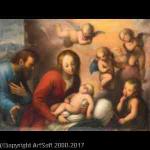Orsola Maddalena Caccia
Orsola Maddalena Caccia
Place: Moncalvo
Born: 1596
Death: 1676
Biography:
Orsola Maddalena Caccia, born Theodora Caccia was an Italian mannerist painter and Christian nun. She painted religious images, altarpieces, and still lifes.
The daughter of painter Guglielmo Caccia and Laura Olivia, she was baptized Theodora Orsola on December 4, 1596. In 1620, she entered the Ursuline convent of Bianzè, where she changed her name to Orsola Maddalena after she took her vows. Four of her sisters had already taken their vows there. Two years later, her other sister joined this convent, reuniting the six sisters together. At the time, Bianzé was a fortified outpost on the frontier between the lands of the Gonzaga, the dukes of Mantua and Monferrato, and the duchy of Savoy and was often in the path of these warring armies. To find a safer home for his daughters, Guglielmo requested and received permission to found the Ursuline convent at Moncalvo from the Bishop of Casale Monferrato, Monsignor Scipione Agnelli. He used his own money and made the houses he owned available to pay for this project. In 1625, Orsola and her sisters moved to the newly founded convent. Her father died a few months after the convent was established and left drawings, set squares, and other art tools for his daughters. Before his death, he had fostered painting as a vocation for the Ursulines of Moncalvo. Out of his six daughters and two sons, Orsola and her sister Francesca, who died at a young age, were his only two children to become painters. She was known as the leader of women in art when it comes to religious painting. Without her, nuns would not have been able to explore their artistic yet religious side. Later in her life, Orsola became the abbess of the convent. She outlived all of her sisters and devoted herself to painting until her death in 1676.
Sister Orsola began her career working as her father's assistant. She learned to paint by mixing the colored pigments for paint and depicting the secondary figures in her father's paintings. She was a prolific artist and the majority of her works are scattered across the many small localities in Monferrat. It is claimed that she painted the first recorded flower painting in Italy.
She went on to organize a painting studio within the convent at Moncalvo, where took on students and assistants of her own. Painting as a trade was encouraged at the convent as it provided a means of support. Several of Sister Orsola pieces were painted on commission. Not only did she commission her works, which she did privately and publicly but she paved the way for nuns to become artists. In two letters addressed to Christine of France written in 1643, she asked to be given an opportunity for paid work as her convent was suffering from poverty.
She helped bring still life painting to Northwestern Italy. The idea of extremely detailed religious art was also because of Orsola. She brought people to realize that scenes of the Bible were very important to the story. She also started to use symbolism in her paintings, such as roses meaning virgin and Ox meaning Jesus’s death.
Sister Orsola created religious genre paintings, altarpieces, and still lifes which varied little over the course of the fifty years she painted. Most of her works convey the repertoire of figurative models and types of composition that she studied in her father's studio during her adolescence. In comparison to her many altarpieces and religious paintings, Sister Orsola created few still life works. She commonly inserted pieces of still life in many of her religious works. These elements of still life are a reflection of the types of objects she had access to in the convent and could study from. Many of her still lifes are considered unusual and notable in their invention and stylistic quality. Each element of her still lifes is meticulously placed and balanced by other figures in the composition. She also depicted various species of flowers and other plants in her works. Orsola's paintings are recognizable as her creations since they are filled with spirituality and are lifelike in their precision. As the years go on, more of her works continue to be discovered and are correctly attributed to her after initial mislabeling.
Sister Orsola's Birth of the Virgin was most likely created around 1635. The original provenance of this image is unknown, making it hard to establish exact year it was created. Originally, it was attributed to her father, then reassigned to the family workshop, and finally identified as one of Orsola's works. In 1838, it entered the Pinacoteca do Estado de São Paulo at the request from Marchese Luigi Malaspina. It is often regarded as one of her best known works. It depicts the sacred tale of the Virgin Mary's birth with a wealth of details. Three women look after Mary's mother Anne who is lying on her bed after labor while three others prepare to wash the newborn child and heat pieces of cloth at a fire. Various still life elements are inserted into this scene which are notable for their precision and quality. For example, a table on the left side of the image has an elaborate, coiled amphora and a tray of fruit with a cut lemon. Also, a young woman who is advancing towards Anne's bed holds a jug of wine and a drinking glass on a round dish. The drapes of the background, the velvet canopy over Anne's bed, the fringe of the tablecloths and blankets, and the lace on the bed sheets are depicted with intense accuracy. This painting has been associated with two drawings by her father as the sources of her inspiration.
More...
Wikipedia link: Click Here




